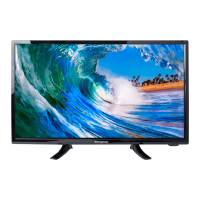
Do you have a question about the Westinghouse WD24HAB101 and is the answer not in the manual?
| Screen Type | led |
|---|---|
| Wall Mount | 200mm x 100mm |
| Tuner | digital |
| Screen Size | 23.6 inches, 24 inches |
| Refresh Rate | 60hz |
| HDR | no |
| Built-In Speakers | yes |
| Speakers Output | 6 watts |
| USB Ports | 1 |
| RF Antenna | yes |
| Headphones Output | yes |
| Digital Optical Audio Outputs | 1 |
| Component Video Inputs | 1 |
| Composite Video Inputs | 1 |
| DVI | 0 |
| Remote Control | standard |
| 3D | no |
| Power Consumption | 58 kilowatt hours |
| Depth with Stand | 5.9 inches |
| Height with Stand | 14.1 inches |
| Width with Stand | 21.6 inches |
| Net Weight with Stand | 5.1 pounds |
| Depth without Stand | 2.9 inches |
| Height without Stand | 12.8 inches |
| Net Weight without Stand | 4.9 pounds |
Critical warnings about electric shock and avoiding opening the unit.
Important safety guidelines for operating and maintaining the TV.
Step-by-step instructions for securely attaching the TV stand.
Advice on stable placement, ventilation, and using approved accessories.
Instructions for safe cable routing and protecting the TV from environmental hazards.
Procedures for safe cleaning, unplugging during storms, and using correct parts.
Guidance on using only manufacturer-recommended parts for repairs.
Overview of the TV's front panel ports and controls.
Details of the TV's rear panel ports for various inputs and outputs.
Guidance on correctly connecting the TV power cord.
Instructions for connecting the TV antenna for signal reception.
Connecting audio and video devices using RCA cables.
Connecting devices using YPbPr cables for enhanced video quality.
Connecting a PC to the TV using VGA and audio cables.
Information on using the TV's USB port for media playback.
Connecting devices via HDMI for digital audio and video transfer.
Explanation of remote control functions for TV operation.
Instructions on how to set up and use the remote control, including battery installation.
Guided initial setup for language and basic configuration.
How to choose the active input source for the TV.
Understanding fundamental operations within the TV's menu system.
Adjusting picture quality settings like brightness, contrast, and color.
Configuring sound settings such as sound mode, bass, and treble.
Managing time-related functions like sleep timer.
Configuring language, OSD timeout, and closed captioning.
Setting parental controls, changing passwords, and system lock.
Managing channel tuning, signal type, and favorites.
Accessing and browsing files from a USB storage device.
Guides users through common TV problems and their respective solutions.
Detailed technical specifications of the TV, including screen size, resolution, and dimensions.